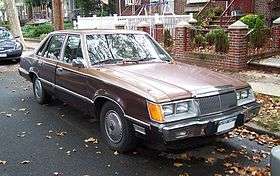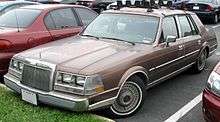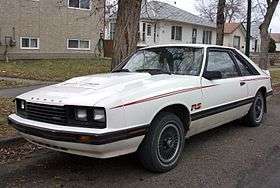Ford Fox platform
| Ford Fox platform | |
|---|---|
|
| |
| Overview | |
| Manufacturer | Ford Motor Company |
| Production | 1979–1993 model years |
| Body and chassis | |
| Class |
Compact Mid-size Personal luxury car Pony car |
| Layout | FR |
| Body style(s) |
two-door convertible two-door coupe three-door hatchback |
| Vehicles | see below |
| Chronology | |
| Successor |
Ford SN-95 platform Ford D2C platform Ford MN12 platform Ford D186 platform Ford CE14 platform |
The Ford Fox platform is an automobile platform that was used by Ford Motor Company in North America for various compact and mid-size vehicles for the Ford, Mercury, and Lincoln divisions. Using a rear-wheel drive, unibody chassis configuration, the Fox platform was used by Ford from 1978 to 1993; a substantial redesign of the Ford Mustang extended its life another eleven years to the 2004 model year. With the exception of the Panther platform, the Fox platform is the longest-produced vehicle architecture by Ford Motor Company.
Designed to be relatively lightweight and simple, the Fox platform was originally intended as the replacement for derivatives of the original Ford Falcon architecture (dating from 1960); the Ford Fairmont and Mercury Zepyhr were introduced to replace the Ford Maverick and Mercury Comet, respectively. As downsizing came into wider use throughout the late 1970s and early 1980s, the Fox platform came into wider use, included in many redesigns and major model shifts.
During the early 1980s, Ford began to phase out the use of the Fox platform, as sedan and station wagon versions were shifted onto more fuel-efficient front-wheel drive platforms; after the 1988 model year, only the Ford Mustang and Lincoln Mark VII coupes remained. For 1994, the Ford Mustang was given a major redesign,
Chassis overview
The Fox platform, like most compact and mid-size cars of the late 1970s, was designed with a rear-wheel drive layout. In contrast to the full-size Fords and Mercurys of the time, the Fox platform used unibody construction.
For the first time in a rear-wheel drive Ford, the Fox platform used MacPherson strut front suspension, continuing the use of a live rear axle suspension configuration. Initially configured with rear drum brakes, 4-wheel disc brakes were added to higher-performance vehicles, including the Lincoln Continental Mark VII, Ford Mustang SVO, 1994-2004 Ford Mustang, and the Ford Thunderbird Turbo Coupe/Mercury Cougar XR7.
Due to the use of strut front suspension, the Fox platform was designed with a wider engine bay than its Falcon-chassis predecessor. As a result, the chassis was flexible in its use of longitudinal engines, accommodating a wide variety of powertrains, including four-cylinder (naturally-aspirated and turbocharged), inline-6, V6, and V8 engines,[1] ranging from a 2.3L inline-4 to a 5.8L V8 (the most powerful Fox-platform car is the 2003-2004 Mustang SVT Cobra with a 390 hp supercharged 4.6L V8). To further improve the fuel economy of Lincoln Fox-platform vehicles in the 1980s, the platform was adapted for the use of BMW diesel inline-6 engines.[2]
The Fox platform was produced in four separate wheelbases, 100.5 inches (for the Ford Mustang/Mercury Capri; lengthened to 101.3 for the SN95 redesign), 104.2 inches (1983-1988 Thunderbird/Cougar), 105.5 inches ("standard"; sedans/wagons), and 108.5 inches ("long"; 1980 Thunderbird/Cougar XR7/ Lincoln Mark VII/ Continental)
Design history
1983 model year changes
During the early 1980s, the Fox platform would be involved in major changes to many Ford nameplates. While the 1980-1982 Ford Granada, Ford Thunderbird, and Mercury Cougar had all seen a sales collapse in the marketplace, fuel prices had stabilized to the point where consumers had shifted back to full-size cars, leading the company to postpone its planned discontinuation of the Panther-platform vehicles. To rectify the sales collapse and capitalize on the move to full-size vehicles, Ford began a major model shift of many of its best-selling vehicle nameplates in all three divisions.
The Lincoln division saw the first changes, with the 1982 Lincoln Continental sedan split from the Lincoln Town Car and shifted into the mid-size segment (allowing Lincoln to again directly compete against the Cadillac Seville). For 1984, the division saw the Continental Mark VI two-door/four-door sedans replaced by the Continental Mark VII. Sharing a wheelbase with the Continental sedan (and the 1980 Thunderbird/Cougar XR7), the Mark VII remained a personal luxury coupe, though far more technologically advanced over its predecessor. Along with a number of other advanced features for its time, the Mark VII was notable for being the first car sold in North America with composite headlights since before World War II.
For 1983, the Ford and Mercury product ranges saw a number of similar changes. The slow-selling Granada was given an update to improve its exterior styling, with the model range adopting the LTD range (the Mercury Cougar sedan/wagon becoming the Mercury Marquis). To reverse their sales collapse, for 1983, the Ford Thunderbird/Mercury Cougar were completely redesigned; while still marketed as a personal coupe, a far greater emphasis was placed on handling over luxury (though not as sporty as a Mustang). In a radical change, the Thunderbird/Cougar were the first production American Ford vehicles to adopt streamlined aerodynamic bodystyling.
As a result of the model shift, the Panther-platform sedan range was shifted upmarket, after being pared down to the highest-trim Ford LTD Crown Victoria/Country Squire, Lincoln Town Car, and Mercury Grand Marquis/Colony Park. The change would also lessen the duplication of mid-size cars in the Ford/Mercury product range, as the Fairmont/Zephyr were replaced by the compact Ford Tempo/Mercury Topaz for 1984 and the Cougar reverted back to its coupe-only bodystyle.
SN-95
By the early 1990s, the Ford Mustang had become the sole model produced on the Fox platform. For the 1994 model year, as the Mustang underwent a major redesign (under the body family program code name Fox-4), the Fox platform itself saw major changes to its architecture. As part of the upgrade, nearly 60% of its parts were redesigned, with major changes to the suspension and improvements to noise, vibration, and harshness (NVH); the updated Mustang-specific platform became known as the SN-95 platform.
The 2003-2004 Mustang SVT Cobra became the penultimate development of the Fox/SN95 platform, with a 390 hp supercharged 4.6L DOHC V8. The SN95 platform would be produced for 11 years, extending the life of the Fox platform to 26 years of production.[3] For 2005, the Mustang was completely redesigned, using the all-new Ford D2C platform.
Discontinuation
As the company entered the 1980s, Ford Motor Company became part of a growing trend among automobile manufacturers in the expansion of front-wheel drive in compact and mid-size vehicles. Alongside the major model shift for 1983, the introductory Ford Fairmont and Mercury Zephyr by the Ford Tempo/Mercury Topaz for 1984. Based on a long-wheelbase version of the Ford Escort, the Tempo/Topaz were intended to compete against the Chevrolet Cavalier, alongside the similar-sized Toyota Camry and Honda Accord (of the time).
For 1986, Ford introduced the front-wheel drive mid-size Ford Taurus and Mercury Sable. While originally intended to replace the larger Panther-platform vehicles, the Taurus/Sable remained in development to replace the Fox-platform LTD/Marquis as the company updated its mid-size product line. For 1988, Lincoln would gain a version of the Taurus as it introduced the first front-wheel drive Continental.
For the 1989 model year, the Thunderbird/Cougar were redesigned, using an all-new platform; while still rear-wheel drive, the new MN12 platform introduced a number of suspension advances over the Fox platform.
After the Mark VII was replaced by the Mark VIII in 1993, the Fox platform was reduced solely to the Ford Mustang, which was redesigned for 1994. Retaining largely the floorpan from the Fox platform, the SN95 would see many upgrades to the suspension and body.
Vehicles
In total, a total of fifteen distinct vehicles were produced on the Ford Fox platform, with the Ford Fairmont, Mercury Zephyr, Ford Durango, Ford Mustang SVO, and Lincoln Mark VII produced exclusively on the architecture. The platform would be produced in a variety of body styles, including two-door and four-door sedans, two-door coupes, three-door hatchbacks, five-door station wagons, two-door convertibles (marking the return of the bodystyle to Ford), and a two-door coupe utility (the last coupe utility produced by Ford in North America).
| Vehicle name | Image | Production | Predecessor | Successor | Wheelbase | Notes |
|---|---|---|---|---|---|---|
| Fox-platform vehicles (compact) | ||||||
| Ford Fairmont |
|
1978–1983 | Ford Maverick | Ford Tempo | 105.5 in (2,679.7 mm) | |
| Mercury Zephyr |
|
1978–1983 | Mercury Comet | Mercury Topaz | ||
| Ford Durango |  |
1981–1982 | Ford Ranchero |
| ||
| Fox-platform vehicles (mid-size) | ||||||
| Ford Granada | .png) |
1981–1982 | Ford Granada (1975–80) | Ford LTD | 105.5 in (2,679.7 mm) |
|
| Ford LTD |  |
1983–1986 | Ford Granada | Ford Taurus | The LTD was an updated version of the 1981–1982 Ford Granada. | |
| Mercury Cougar (fifth generation; sedan/station wagon) |
 |
1981-1982 | Mercury Monarch | Mercury Marquis | Cougar sedan and wagon models were discontinued after the 1982 model year. | |
| Mercury Marquis |  |
1983[4][5]–1986 | Mercury Cougar | Mercury Sable | ||
| Lincoln Continental (sixth generation) |
 |
1982–1987 | Lincoln Versailles | Lincoln Continental (D186/seventh generation) | 108.5 in (2,755.9 mm) | |
| Fox-platform vehicles (Pony car) | ||||||
| Ford Mustang |  |
1979–1993 | Ford Mustang II | Ford Mustang (SN-95) | 100.5 in (2,552.7 mm) | |
| Ford Mustang SVO | 1984-1986 | none | Ford Mustang SVT Cobra (1993) | Ford Mustang with 2.3L turbocharged engine and suspension, brake, and bodywork modifications. | ||
| Ford Mustang (SN-95) |  |
1994–2004 | Ford Mustang | Ford Mustang (S197) | 101.3 in (2,573.0 mm) | |
| Mercury Capri |  |
1979–1986 | Mercury Capri II | 100.5 in (2,552.7 mm) | Mercury version of Ford Mustang; different rear bodywork from 1983-1986 | |
| Fox-platform vehicles (personal luxury car) | ||||||
| Ford Thunderbird
(eighth generation) |
 |
1980-1982 | Ford Thunderbird (seventh generation) | 108.5 in (2,755.9 mm) | First Thunderbird produced with 6-cylinder engine as standard. | |
| Ford Thunderbird (ninth generation) |
 |
1983–1988 | Ford Thunderbird (tenth generation / MN-12) | 104.2 in (2,646.7 mm) | Turbo Coupe is first four-cylinder Thunderbird. | |
| Mercury Cougar XR7
(fifth generation) |
 |
1980-1982 | Mercury Cougar (1977-1979) | 108.5 in (2,755.9 mm) | Separate wheelbase and bodyshell from Cougar sedan/station wagon; same powertrains as Ford Thunderbird. | |
| Mercury Cougar (sixth generation) |
1983–1988 | Mercury Cougar (seventh generation / MN-12) | 104.2 in (2,646.7 mm) | Return to single model line; Cougar XR7 is sold as Mercury version of Thunderbird Turbo Coupe from 1983-1986, replaced with V8 engine in 1987. | ||
| Lincoln Continental Mark VII |  |
1984–1992 | Lincoln Continental Mark VI | Lincoln Mark VIII | 108.5 in (2,755.9 mm) | The Mark VII was the first American-market car sold with composite headlamps and anti-lock brakes. |
References
- ↑ Lamas, Jonathan. "Third Generation Mustang (1979-1993)". About.com. Retrieved 14 March 2016.
- ↑ Sass, Rob (2013-02-01). "Few Thrills With a Diesel Continental". New York Times. Retrieved 14 March 2016.
- ↑ Lamas, Jonathan. "Fourth Generation Mustang (1994-2004)". About.com. Retrieved 14 March 2016.
- ↑ Mercury Cougar
- ↑ Mercury Cougar
